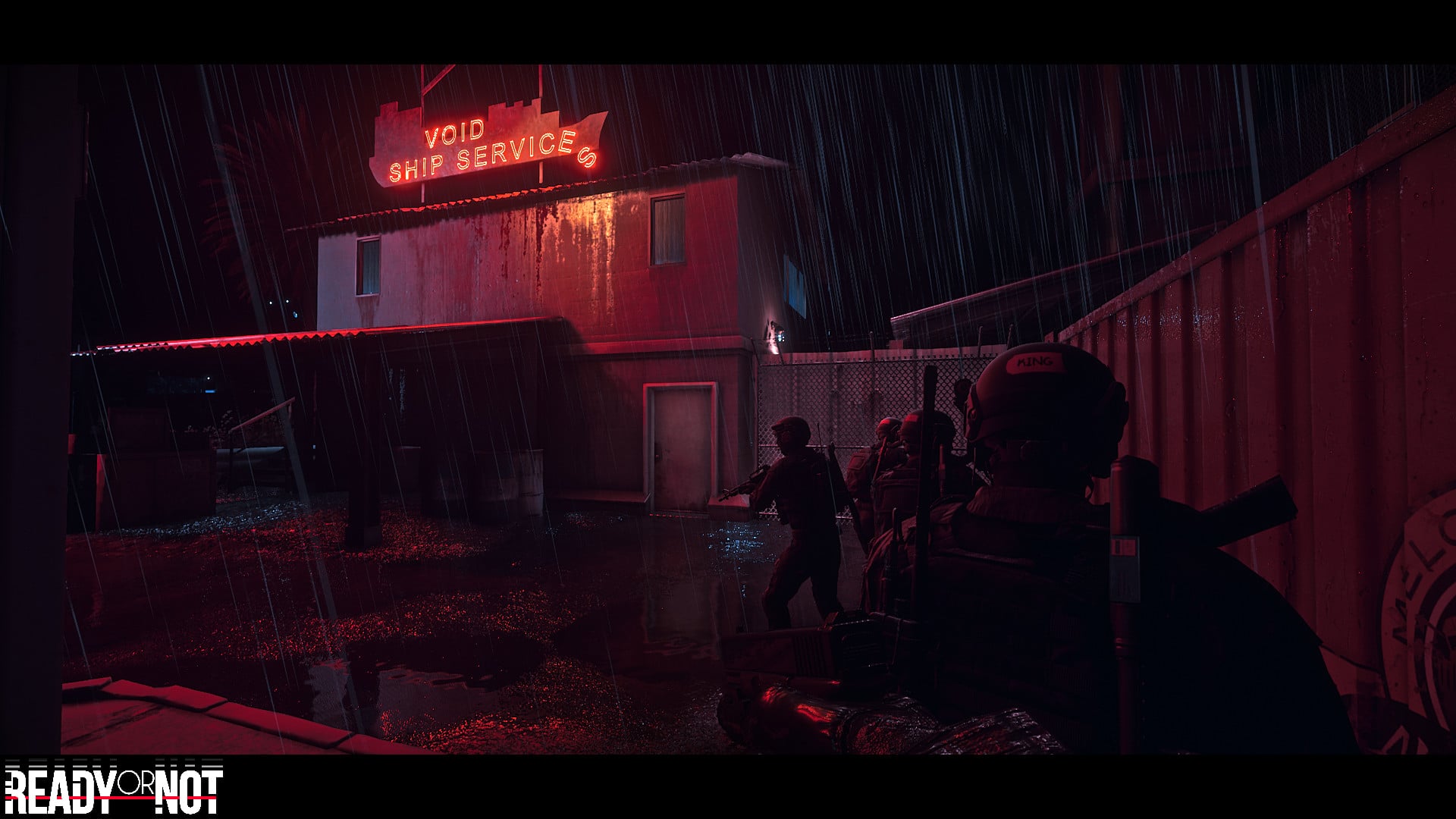In its presentation of power and powerlessness, Ready or Not is terrifying. VOID Interactive’s much anticipated and now controversial debut looks like a shooter but feels more like a horror experience. It’s claustrophobic, tense, and unintentionally subversive. The more you play, the more the sense of wrongness creeps up on you and settles in. When you finally step away, it’s with a sigh of relief and a tingling sense that what you’ve just played points to uncomfortable truths.
Ready or Not has something that looks vaguely like a narrative impetus if you squint hard enough. You’re a SWAT officer taking down criminals in a city with a sky-rocketing crime rate – and those criminals aren’t afraid to meet force with force. Beyond this vague promise that you’re bringing order to a lawless place, there’s no diegetic reason to dive in. However, for what Ready or Not wants to be, that’s enough – at least to start with. The player’s motivation is to conquer the game’s old-school level challenge approach.
Once you choose a location from the city map, you’re dropped in with a significant tactical disadvantage. You don’t know how many enemies are present or the layout of the labyrinthine urban settings. Compounding that, the levels tend to be dark and tight in their design, rife with locked doors and blind corners. These kinds of design cues are deeply embedded in the horror genre, raising echoes of Resident Evil, Perception, or Until Dawn.
Like with some of the best in the genre, the horror potential in Ready or Not stems from transgressing the boundaries of normal. The settings tend towards the kinds of places that make up the everyday fabric of towns and cities: houses and hotels, a car dealership and a gas station. However, the level design makes these usually safe spaces feel unsafe. It’s an unsettling juxtaposition. Underscoring the ambient invocation of fear are the very real and ever-present gameplay threats.

You can have all the firepower in the world, but that won’t save you if you’re ill-prepared to use it. That’s a lesson Ready or Not is all too ready to teach. Some doors are booby-trapped. Sometimes, enemies will camp in opportune positions, trying to take you out before you even notice them. The danger is constant. And despite your tactical armor, you’re still just a fleshy human. Open firefights rarely end well. Instead, you have to move slowly through the locales, checking doors for traps, forcing targets to surrender one by one by kicking in the doors they’re hiding behind with a show of overwhelming force.
With all of that in mind, you might think that Ready or Not delivers a sense of triumph and heroism. You’re overcoming impossible odds and bringing the baddies to justice.
You’d be wrong.
Despite your disadvantages and the paper-thin contextualization for your actions, you’re an invader to these spaces. You’ve got a sizable squad for backup and military-grade equipment that you’re using to bust in on people. You remain a vivid manifestation of state power being wielded like a blunt club.
Your entire purpose in Ready or Not is to defuse situations that you are told in the vaguest terms possible threaten social order. To be fair, the mission debriefings note that bullets should only be used as a last resort, and the scoring system rewards captures more than kills. However, these non-diegetic elements stand in contrast to the moment-to-moment gameplay.

Violence is etched in almost every interaction with the game world. Doors get kicked or blasted open. Flashbang and stinger grenades disorient hostiles long enough for you to force them into surrender. Gunfights can erupt with minimal provocation. To a degree, all of that is expected. Ready or Not may be a horror-tinged, urban-centered experience, but it remains a shooter at heart.
The truly unsettling interactions are those between your squad and hostage NPCs. These are supposed to be the victims of crime, but far from immediately extracting them from the danger zone or even treating them with kindness, your only option is to restrain them and call their presence in to an operator. Maybe it makes sense. Maybe it’s about ensuring they’re not a plant. Maybe…
That’s where Ready or Not‘s shortage of narrative framing creates a problem. In the absence of a reason for the heavy-handed, punitive course of action, no matter how much I try to justify this treatment of the presumably innocent, it feels callous. It’s an expression of violence meted upon those who are already the victims of violence. In that context, you’re not a hero. All you’re doing is reinforcing the trauma of the experience. You’re bringing force to bear in what should be the safe spaces of home and work environments. I can’t help but feel as if I’m even more of a villain than the supposed hostiles, which presents yet another form of horror.






Published: Jan 9, 2022 11:00 am